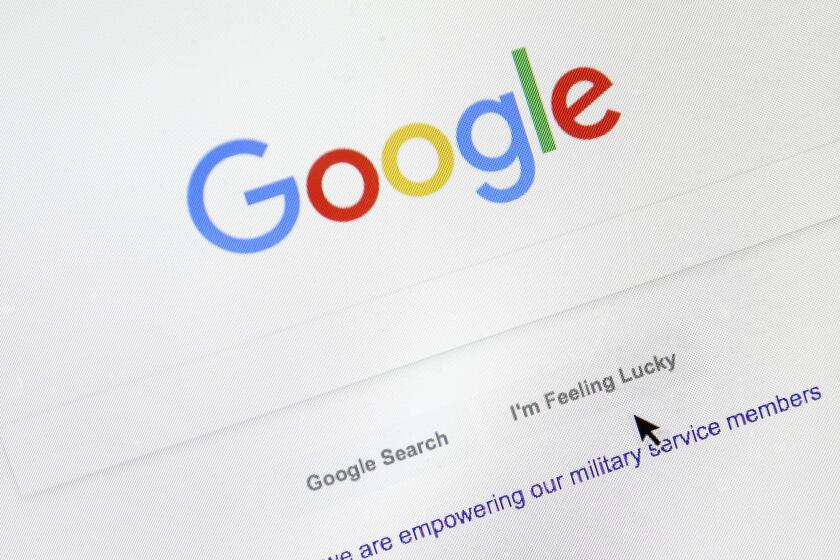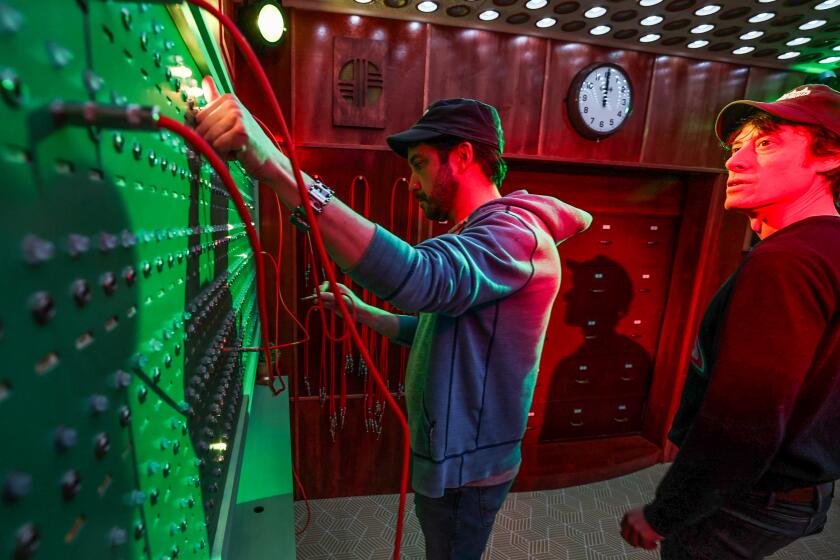Game is afoot for Sony’s PlayStation3
Let the games begin.
Video game enthusiasts are lined up outside stores across Southern California today hoping to buy Sony Corp.’s PlayStation 3 -- a hotly anticipated machine that kicks off a three-way race for dominance in the $30-billion games business.
Demand for PlayStation 3 will far outstrip supply when the console, priced from $499 to $599, goes on sale at 12:01 a.m. Friday. Sony shipped only 400,000 units to the United States; an allotment of 100,000 sold out in one day when the PS3 debuted in Japan last week.
Success is crucial for Sony, the beleaguered Japanese electronics and entertainment giant that is trying to defend its top spot in gaming against rivals Microsoft Corp. and Nintendo Co. For Sony and Microsoft, game machines offer a toehold into the living room as the two vie to control Internet delivery of movies and music.
“The consoles themselves have enough horsepower to handle strong, media-centric content. Broadband deployment is rapidly on the rise and homes are increasingly networked. And these consoles will be always on and connected,” Michael Gartenberg of Jupiter Research said. “That provides new opportunities that simply haven’t existed in the past.”
The video game industry’s influence extends well beyond its billions in sales, which exceed global box office receipts. Many teens and young adults prefer playing games to watching television or going to the movies. And the rapid-fire visual aesthetic of games has migrated to TV shows and films.
“We’re talking about a global phenomenon,” said Henry Jenkins III, founder and director of the Comparative Media Studies Program at MIT and author of “Convergence Culture.”
“For the teens and college-age students, it’s the dominant entertainment medium of choice. Bar none,” he said.
*
First in line
At the Circuit City in Hawthorne, more than 120 people pitched tents and camped out in the parking lot -- some since Sunday night -- for the opportunity to buy one of the 100 PS3s rumored to go on sale there at midnight.
Hawthorne resident Raul Vallejo, 36, was among the first to arrive at 9 p.m. Sunday, with his 14-year-old son, Joey. The pair toted a cooler filled with provisions and two PlayStation Portable hand-held game systems to pass the time. Vallejo said he unsuccessfully tried to place advance orders online and at three stores.
“I’m not going to miss this, so I took four days off,” said Vallejo, who has owned every video game system to come out since 1977’s Atari 2600.
Those at the end of the line are likely to go home empty-handed because Sony has been unable to manufacture enough consoles to meet demand. The PlayStation 3 is a complex piece of hardware with nine microprocessors that has computational power rivaling the machines used to create virtual reality rides at Disneyland, said Richard Doherty of research firm the Envisioneering Group.
By year-end, Sony hopes to ship 1 million units to the United States. Getting the consoles in living rooms is key to helping Sony return to profitability and to serve the company’s broader aspirations.
The system is a Trojan horse to establish Sony’s format for the next generation of DVDs, called Blu-ray. That could spark sales of the high-definition movie discs sold by Sony’s movie studio and Bravia televisions made by its consumer electronics group.
Kaz Hirai, president and chief executive of Sony Computer Entertainment America, sought to downplay expectations.
“I think that the PlayStation 3 launch is obviously a very important product launch for Sony, but I think a lot of people have tried to cast it in the light of make or break for Sony,” Hirai said. “It’s a very important launch. To say it’s make or break or the entire future of Sony is riding on just one product is an oversimplification.”
The stakes are equally high for Nintendo, which revived the video game industry in the late 1980s but was overtaken by Sony and Microsoft.
The Wii console, out Sunday, is Nintendo’s attempt to stay alive by flouting the conventional wisdom that gamers want ever-more powerful systems and placing its emphasis instead on simplicity and fun. (Hence the name, pronounced “whee”.)
The $250 system’s novel game controller is emblematic of this strategy: It dispenses with the usual array of buttons and replaces it with a remote-control shaped device that senses motion. Swing the controller like a baseball bat and the character on screen responds.
“They’re the great underdog story of the holiday,” said P.J. McNealy of American Technology Research. “In my opinion, the console sells itself with the hands-on experience. The more people actually play it, the more converts there will be.”
Nintendo’s unorthodox strategy could help break the video game industry out of its rut. The percentage of households that own a video game console has remained flat for the last decade, hovering at around 36%, according to Odyssey, a San Francisco research firm. It’s not the same people who buy again and again, but rather the same types of consumers: Those households are disproportionately young, affluent and have children at home.
“What that says is that this experience appeals to a particular subset of people,” Nick Donatiello, Odyssey’s chief executive said. “Part of the challenge for a bunch of these games is it takes time to develop the skill to really enjoy them. And there’s a limit to the proportion of people who are willing to invest the time to get good enough for it to be really fun.”
*
Opening for Windows
Microsoft, meanwhile, is looking to move toward profitability in gaming with the console it introduced last November, the Xbox 360. The software giant has invested billions on its game machines but has yet to make a penny.
As with Sony, Microsoft has aspirations for the Xbox that go well beyond gaming: namely to expand its Windows platform beyond the PC and, in the process, control the standards for digital home entertainment.
“We have a lot of value to add to the consumer who was starting to get befuddled about where technology was meeting entertainment -- and that is right at the television set,” Microsoft Vice President Peter Moore said. “The cleverness of how you bring it all together is in the software.”
Consumers devote not a word to corporate strategies as they compare notes on how to obtain a coveted console in online forums. Matt Harward, 36, a real estate investment advisor and radio host in Phoenix, said his wife forbade him from camping out to get a PS3, so he wrote a software program to grab a console as soon as it’s listed in Amazon.com’s inventory.
“Of course, it took me a week to write the thing,” Harward said. “Only a true geek can justify taking a week to write software that will save him a few hours.”
*
*
(BEGIN TEXT OF INFOBOX)
Comparing the consoles
Sony PlayStation 3
Features: An advanced “cell” processor with a main unit and eight co-processors, a Blu-ray Disc drive that plays movies and games in high-definition, and broadband connectivity.
Price: $499 for a system with a 20-gigabyte hard drive; $599 for a 60-gigabyte hard drive with WiFi networking.
Available: Friday
---
Nintendo Wii
Features: A remote control that is the size of a TV remote and senses motion to control game play.
Price: $250
Available: Sunday
---
Microsoft Xbox 360
Features: A three-core processor, a separate graphics processor, high-definition video and the Xbox Live online marketplace for downloading game trailers, music videos and movies.
Price: $299 for the base system without a hard drive; $399 with a 20-gigabyte hard drive, wireless controller and headset.
Available: Now
---
Graphics reporting by Dawn C. Chmielewski



